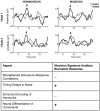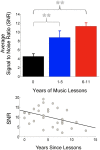Art and science: how musical training shapes the brain
- PMID: 24137142
- PMCID: PMC3797461
- DOI: 10.3389/fpsyg.2013.00713
Art and science: how musical training shapes the brain
Abstract
What makes a musician? In this review, we discuss innate and experience-dependent factors that mold the musician brain in addition to presenting new data in children that indicate that some neural enhancements in musicians unfold with continued training over development. We begin by addressing effects of training on musical expertise, presenting neural, perceptual, and cognitive evidence to support the claim that musicians are shaped by their musical training regimes. For example, many musician-advantages in the neural encoding of sound, auditory perception, and auditory-cognitive skills correlate with their extent of musical training, are not observed in young children just initiating musical training, and differ based on the type of training pursued. Even amidst innate characteristics that contribute to the biological building blocks that make up the musician, musicians demonstrate further training-related enhancements through extensive education and practice. We conclude by reviewing evidence from neurobiological and epigenetic approaches to frame biological markers of musicianship in the context of interactions between genetic and experience-related factors.
Keywords: brain; cognition; musical training; neural plasticity; talent.
Figures




References
LinkOut - more resources
Full Text Sources
Other Literature Sources

